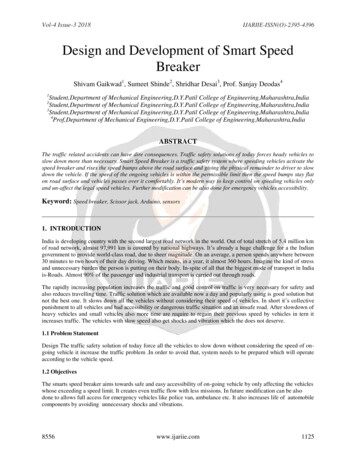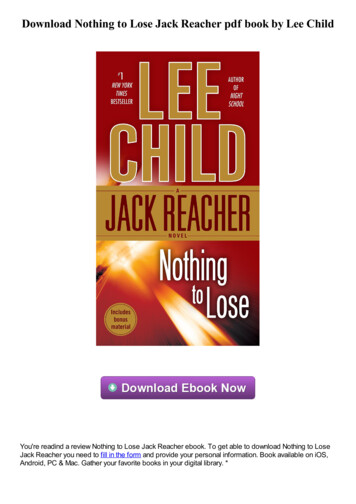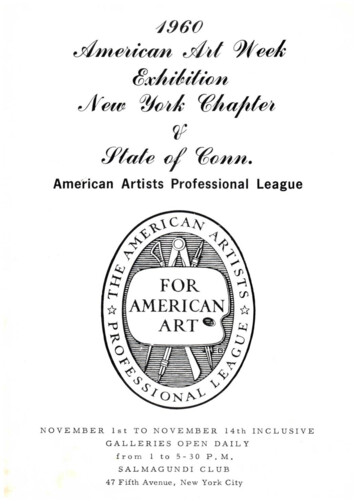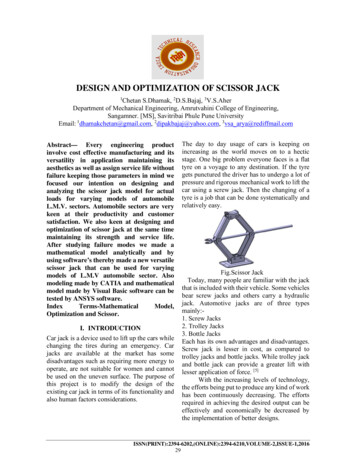
Transcription
English Association Key Stage 3 Bookmarks Number 1Jack SchaeferSHANE (1949)byPeter CashEnglish Association Key Stage 3 BookmarksNo. 10 English Association and Peter Cash 2013
English Association Key Stage 3 Bookmarks Number 1Jack Schaefer (1907-1991)SHANE (1949)byPeter CashBIBLIOGRAPHYJack Schaefer, Shane, 1949.BOOKS TO READArthur Conan Doyle, The Adventures of Sherlock Holmes, 1892.John Steinbeck, Of Mice and Men, 1938.Ian Fleming, From Russia with Love, 1957.Stephen Matterson, American Literature, Arnold 2002.Jim Cullen, The American Dream, OUP 2003.FILMS TO WATCHGeorge Stevens, Shane, Paramount 1953.Clint Eastwood, Pale Rider, Warner Bros 1985.NOTESJack Schaefer’s novel Shane (1949) communicates one of the most powerful of all ideas: that thereexists in the world a force for good supernaturally superior to any force for evil which it mayencounter. In classical terms, any such narrative is inherently dramatic, for it inevitably involveshubris on the part of the evil-doers which invites and meets its nemesis. Between Schaefer’s novelShane and Clint Eastwood’s film Pale Rider, each of the similarities involves an exhibition of thishubris, almost schematically so.The first purpose of this essay is to show that Jack Schaefer is story-telling in such a tradition. Forinstance, Shakespeare’s plays, informed by the Aristotelian model, are early admirers of this ethic: inHamlet, King Lear, Macbeth and The Winter’s Tale, order is shown naturally to re-assert itself;breaches in nature heal themselves, rather as skin-wounds do. To an understanding of these plays,my adverb ‘naturally’ is central; there, the writer is eager in the age of the Gunpowder Plot (1605) toreassure his audiences that all shall be well, that any threat to the social order will be contained bythe very nature of things. In these plays, the Fortinbras-figure/the Malcolm-figure is not asuperintendent of the action, conducting it towards a just conclusion; rather, Great Creating Naturecan be trusted to re-establish order for itself. For King Lear, the setting is Ancient Britain: in other1 English Association and Peter Cash 2013
English Association Key Stage 3 Bookmarks Number 1words, the action takes place before the birth of Christ. The gods of that play are the forces ofnature, not benign overlords or intercessors.In 1859, Charles Darwin published a scientific work entitled On the Origin of Species; in 1886,Arthur Conan Doyle, a doctor, wrote a detective story entitled A Study in Scarlet. For the postDarwinian age, it is entirely appropriate that Sherlock Holmes should avow that all threats to thesocial order/the metropolitan status quo can be successfully met by the application of human logicand scientific method: significantly, the very first epithets for Holmes are ‘an enthusiast in somebranches of science’ and ‘a first-class chemist’. For a reassuring certainty, readers still need not lookbeyond the scope of natural history and forensic science: indeed, Watson’s first meeting with Holmesis in a laboratory at Bart’s Hospital where he is elated at having just devised an ‘infallible’ test fordifferentiating blood-stains from mud-stains. It is what Conan Doyle does next that needs noticing: inSherlock Holmes, he creates a man apart. For the post-Darwinian age, he creates a character whoseknowledge of science (‘the science of deduction’) sets him apart from the ordinary mortals by whomhe is surrounded. He is presented not as a professor who goes home each night for tea with his wife,but as a cross between Dr John Dee (1527-1609) and a music hall magician. Indeed, Doyle, to assistthis perception, surrounds him with men of education – Dr Watson, Inspector Lestrade, InspectorGregson – whose function it is to be ‘astonished’ by Holmes’ powers as ‘a consulting detective’. Forthe development of this particular character, it was no hindrance to Doyle that, on 31 st August 1888,somebody murdered Mary Ann Nichols in Whitechapel and the Lestrades of the Yard failed to findboth her killer and the identical killer of four further women. With a proleptic irony, Doyle, in 1886,had put the following sentiments into Watson’s mouth:“You remind me of Edgar Allen Poe’s Dupin. I had no idea that such individuals did existoutside of stories.”By 1893, Doyle’s acknowledgement of his debt to Poe (The Murders in the Rue Morgue, 1841)had chimed loudly with the popular perception: that, if Sherlock Holmes ‘did exist outside of stories’,then he’d have nabbed the Ripper in next to no time. There is nothing anachronistic here: in AStudy in Terror, made at Shepperton Studios in 1965, no less an actor than John Neville portraysHolmes in successful pursuit of the Ripper. Infallible, you see.It was not until 1938 that American fiction produced such a hero and not then in either a play or anovel, but of course in a comic book. Clark Kent is a character who grows up on a farm and laterfinds employment as a newspaper reporter; he is the sort of guy who would regularly go home to hismother for tea, but differs from Sherlock Holmes in a rather more famous respect: namely, that hispowers are supernatural – to which precise extent he is a super-hero. Created by writer Jerry Siegeland artist Joe Shuster, the character of Superman – into whom Clark can transform himself in a twirl– first appeared in Action Comics (June 1938) and then featured in a variety of radio serials. Insuch comic strips, the science is not natural, but fiction; in such fantasies, wrongs can be righted (eg.hubristic villains can meet their nemeses) by bionic means.It is instructive to note that Superman evolved in response to the decade after the Wall Street Crashof October 1929. It was an era that called for a swashbuckling rescuer in the mould of DouglasFairbanks, a noble pioneer after the spirit of Charles Lindbergh . Consequently, the values forwhich Superman stands are the American values of President Roosevelt’s New Deal: activecompassion for vulnerable individuals, bold concern for the welfare of impoverished communities.The common target is corporate greed: frequently, Superman’s crusades are against corruptbusinessmen and politicians, megalomaniacs (epitomised by Lex Luthor) whose private schemes formoney-making run contrary to the public good. Superman (Kal-El) is not the son of God, but he isthe son of Jor-El – which, as Hebrew speakers will know, is much the same thing. It is alsoinstructive to reflect that Siegel and Shuster are Jewish and that their super-hero is a stranger fromanother land who has changed his name to conceal his true identity.For these reasons, I think that it is by way of Superman (1938) that we need to approach Shane(1949). Shane himself is not a comic book hero, but a credible cowboy: in Wyoming, in 1889,2 English Association and Peter Cash 2013
English Association Key Stage 3 Bookmarks Number 1‘another stray horseman’ was not unusual. At the same time, Schaefer’s writing – his use oflanguage, his organisation of narrative – leaves us in no doubt that Shane is none other than theResurrected Christ, travelling from Cheyenne, rather as the Risen Christ travelled the road toEmmaus, quite unrecognised by his disciples. Only slowly does it dawn on the folks among whom hemoves that his powers – eg. of ‘fierce concentration’ – are superhuman.The context for Shane is given by Stephen Matterson in American Literature (2002):Homestead Act Passed in 1862, the Act opened up lands in the Mid-West and West tosettlers. Any citizen (or intending citizen) who was either over the age of twenty-one orthe head of a family was entitled to ownership of 160 acres of land for no charge,provided a 10 filing fee was paid and the land was occupied for at least ten years and acrop raised on it.“Go West, young man, go West and grow up with the country,” advised Horace Greeley in The NewYork Tribune of 13th July 1865 and west thousands of families duly went, looking for a place to settleand make a sweet home. In Shane, Schaefer’s first-person narrator Robert McPherson Starrett(Bob/Bobby)1 is an adult reflecting upon an episode from his boyhood on such a homestead. InChapter I, Joe Starrett states straightaway what he and his wife Marian are doing in the wilds ofWyoming: “The thing to do is pick your spot, get your land, your own land.” In Chapter VI, the adultnarrator actually refers to the Homestead Act in order to explain his father’s thinking: “The land wasours by right of settlement, guaranteed by the government.” Unfortunately, this westward migrationcreated a conflict between the rancher who wanted his cattle free to roam the open range and thefarmer who wanted to file a claim to his own part of the range: that is, enclose a small ‘piece ofground’ for himself and establish a homestead. 2 In Shane, Luke Fletcher is ‘the big man in ourvalley’/the ‘big-hatted rancher’ (Chapter IV); thwarting his progress are the ‘decent men and goodneighbours’ of the farming community (Chapter XI) whose embryonic town stages the confrontationsbetween these two factions/value-systems.In Shane, the homestead is an emblem of the American values which the Starrett family steadfastlyembodies.3 Pointedly, Schaefer’s choice of epithet endorses these values: by my count, he refers tothe ‘homesteaders’ on no fewer than nineteen occasions. Foremost among the things which are‘clean and solid and right’ (Chapter II) is self-respect. Schaefer crafts this argument carefully. InChapter VIII, Shane, talking to Bob, accounts for his treatment of Chris in terms that echo Christ’sSermon on the Mount:“I let him ride me and I gave him his chance. A man can keep his self-respect withouthaving to cram it down another’s throat.”Shane is expounding a Christian pacifism: in effect, he is counselling Bob not to ‘resist an evil person’:“If someone strikes you on the right cheek, turn to him the other also” Matthew 5.38. It issignificant that Shane forsakes this doctrine only after Fletcher’s henchmen have ganged up on himand hit his other cheek: ‘. the fist missed the jaw, tearing along the cheek, the heavy ring on onefinger slicing deep’ (Chapter IX). In Chapter XI, Joe Starrett is to be heard voicing identicalsentiments:“A man can stand for a lot of pushing if he has to . But there are some things a mancan’t take. Not if he’s to go on living with himself.”When he played the role of Joey Starrett in George Stevens’ 1953 film of Shane, Brandon De Wilde (19421972) was aged 9.2For Oklahoma! Oscar Hammerstein II (1943) had even written a lyric – The Farmer and the Cowmanshould be Friends – that makes fun of this antagonism.3 In John Steinbeck’s Of Mice and Men George Milton and Lennie Small had likewise dreamed often of ‘a littlepiece of land’ (1937).13 English Association and Peter Cash 2013
English Association Key Stage 3 Bookmarks Number 1In this speech, Joe identifies the point at which it becomes absolutely necessary for a man (even aChristian pacifist) to stand up and be counted. It is for this reason that Shane looks at Joe’s littleherd ‘like it meant more to him than lazy steers fattened for market’ (Chapter VIII). Schaefer ismaking clear that the homestead is primarily of symbolic importance: consequently, a failure todefend it would involve an unacceptable loss of self-respect. For Shane, an outrage against thehomesteader – such as Stark Wilson’s shooting of Ernie Wright – signals the moment when he knowsthat he must strike back: “I’m making this my business” (Chapter XIII). As he sets off for his showdown with Fletcher and Wilson, Shane – “It’s a lovely land, Bob” – confirms the supreme value of thehomestead. Because he respects family values, Shane takes no advantage of Marian’s sexualattraction to him; by contrast, the Preacher (Pale Rider) can make love to Sarah because she is awidow whose relationship with the worthy prospector Hull Barret is still platonic.Ancillary values are motherhood and apple-pie, traditional metaphors for the wholesome goodness ofAmerican home-life. Schaefer’s narrative makes an explicit point of Marian’s fitness for both bedroomand kitchen, endorsing her value as wife and mother by serial references to her coquettishness and toher cooking, especially to her facility for baking ‘a deep-dish apple-pie’/‘prime pie’. This said,Schaefer’s presentation of Marian Starrett is not ultimately sexist. When her husband Joe considersfor an instant that discretion might be the better part of valour, it is she who argues vehemently that‘running away’ to Montana ‘would be worse’ than staying to fight; she calculates that, if theycapitulate, then the cost to her family’s integrity, its sense of itself, will be permanent (Chapter XI).It is instructive that Shane (‘not tied to any particular time or place’) is without a background. In thisrespect, he anticipates The Man With No Name in Sergio Leone’s trio of Spaghetti Westerns (19641966) and Clint Eastwood’s own ghostly protagonists in High Plains Drifter (1973) and Pale Rider(1985). The novel is remarkable for its cinematic opening: only slowly does Schaefer, preparing usfor the first appearances of Eastwood’s two horsemen, bring his mounted figure into focus. Thestructure of the prose is anaphoric: ‘He rode into our valley .’, ‘He rode steadily on .’, ‘He rodeeasily . ’, ‘He drew rein .’ Such progress is dramatic: only after thirteen uses of the third-personpronoun does the description of ‘the man himself’ give way to an epithet, ‘the stranger’, itself thenused no fewer than seven times before the dark figure invites the Starretts to call him by hismonosyllabic name, which, rather than clear up the mystery, just intensifies it. “Call me Shane” – asif to say, “That’s not who I am, but it’s what you can call me.” For ‘this Shane’, Schaefer creates anaura: to this end, his second technique is to apply to him abstract nouns which, by their veryvagueness, elude complete comprehension.In Chapter I, he twice refers to the ‘kind ofmagnificence’ which Shane exudes; presumably, this [ not ‘magnificence’ itself, but a ‘kind’ of it] is aquality which, at the same time as it elevates his protagonist above mere mortals, resistscontradiction. In Chapter XIII, Schaefer recalls this ‘mysterious’ quality: now, it is ‘that dark andworn magnificence’, still something luminous, but no nearer definition. From the outset, the Starrettshave detected in Shane’s nature a ‘tension’ which this oxymoron encapsulates: between an innate‘gentleness’ [towards the virtues of the homestead] and an ‘indescribable deadliness’/‘a silent,inevitable deadliness’/ a ‘slim deadliness’ [towards the evils that imperil it]. In Chapter III, Shane’seyes are said to be ‘aflame with a concentrated cold fire’; in Chapter IV, his gun is ‘beautiful anddeadly-looking’. Like Robin Hood, like Wilhelm Tell, Shane (‘the flowing brute beauty of line andpower in action’) is a complicated folk hero in that he does good by means of his exceptionalexpertise with a ‘deadly’ weapon. In Chapter V, Shane tells Bob, “A gun is as good – and as bad – asthe man who carries it.”Towards a fuller understanding of this tension, the following scripture helps: “Beloved, never avengeyourselves, but leave it to the wrath of God, for it is written, “Vengeance is mine. I will repay, saysthe Lord” (Romans 12.19). The tension in Shane comes of having continually to calculate anappropriate response to the threat which the Starretts’ homestead faces; indeed, his affinity with JoeStarrett can be said to emanate from a shared admiration for ‘the right kind’ of ‘toughness’ (ChapterII). As a poetic consequence, Schaefer refers continually to Shane’s physical and spiritual alertness.In Chapter I, Bob notices that Shane wears ‘a frown of fixed and habitual alertness’. In Chapter II,Shane is ‘tense and alert’; in Chapter IV, he is notable again for his ‘fixed alertness’; in Chapter V, heis both ‘alert and watchful’ and then remarkable for his ‘conscious alertness’; in Chapter VII, he is ‘asalert and watchful as ever’; by Chapter XII, he is ‘relaxed and watchful’. Shane, then, is constantly4 English Association and Peter Cash 2013
English Association Key Stage 3 Bookmarks Number 1vigilant, watching for the point at which it becomes morally imperative to exact proportionateretribution upon Fletcher and his hired hands.Like Sherlock Holmes, Shane is ‘a man apart’: “Yet you always felt in some indefinable fashion that hewas a man apart” (Chapter IV). At the same time, Shane is indefinably different; towards ademonstration of this difference, Schaefer’s descriptions work patiently. In Chapter IV, Joe Starrettsupplies Shane with anecdotal evidence of Luke Fletcher’s tactics; in this anecdote, he recounts howtwo of Fletcher’s boys had roughed up ‘the young fellow’ whom he had hired, effectively running himout of town. In Chapter VI, we learn what the name of Joe’s intimidated farm-hand was:“I had seen Morley come back from town, bruised and a beaten man, and gather histhings and curse father for hiring him and ride away without once looking back.”Bobby is intrigued to notice that Shane is indifferent to Young Morley’s plight and he is not slow tounderstand why: “It was because he was not Morley. He was Shane.” Schaefer’s nomenclature isportentous: ‘not Morley’. In this expression, it is difficult not to hear a pun: ie. Shane, an incarnationof the Holy Ghost, is not daunted by the prospect of an encounter with Fletcher’s thugs because he is‘not mortal’. Such an interpretation accounts for Shane’s ‘inflexible’ refusal (“No!”) to let Joe Starrettaccompany him to the final show-down (Chapter XIV). The reason why he forcibly waylays JoeStarrett is that Joe is mortal. Because Shane is an agent of a superior/supernatural power,vengeance is his.The fundamental similarity between Shane and Pale Rider is the relationship between the strangerand a nuclear family whose lawful livelihood is being threatened by a ruthless entrepreneur (CoyLaHood) and his hired guns (Stockburn and his six deputies). In Pale Rider, the eponymouschevalier (Clint Eastwood’s character, the Preacher) is not Christ, but the Fourth Horseman of theApocalypse: “When the Lamb opened the fourth seal, I heard the voice of the fourth living creaturesay, “Come and see!” I looked and there before me was a pale horse! Its rider was named Death,and Hell was following close behind him” (Revelation 6.7). In Pale Rider, the child of the family isnot a nine-year-old boy but a fourteen-year-old girl (Megan) and the physical attraction between thestranger and the wife-figure (Sarah) is consummated. On the other hand, the hubris of LaHood’smen meets its nemesis first after they assault Hull Barret outside the hardware store and finally afterthey confront the Preacher on the streets. Between Schaefer’s narrative and the narrative for thisfinal show-down, the parallels are even plainer: what triggers the Preacher’s decision to exactrevenge is the Ernie Wright-style shooting, by Stockburn and his deputies, of the drunken/harmlessprospector Spider Conway; when Hull Barret announces his determination to accompany the Preacherinto town, the Preacher, seated on his pale horse, scares off Hull’s brown horse and goes alone to setthe world right again.Watching Pale Rider, the reader of Shane will continue to notice other likenesses or nearlikenesses: whereas Joe Starrett and Shane join forces against a recalcitrant tree-stump, Hull Barretand the Preacher work together on a huge boulder. Eastwood’s film re-enacts Schaefer’s tale,quoting from it approximately, but ultimately paying homage to its dramatic movement, its classicalarc – terminating at that high noon when the hubristic gunslinger meets his nemesis in the form ofthe pale rider. For his film of Shane, made in 1951, but released in 1953, George Stevens cast AlanLadd, a matinee idol of the day. No less an authority than David Thomson ( Have You Seen? 2008)feels that, although Ladd ‘was not natural casting’, he is ‘astonishing’, is ‘ennobled’, ‘acquires grace’.Steady on: with such an encomium, there are reasons to differ. Although Ladd (then aged 38) hadbeen an accomplished diver, he lacks Shane’s ‘lithe’ athleticism; he stands no taller than 5 feet 6inches, has sloping shoulders and is not likely to arouse any ‘curious intentness’; moreover, “Ladd inbuckskins now is a little too close to gay iconography maybe” (Thomson). No ‘maybe’. AlthoughShane is ‘not much above medium height’, he is no slouch; although he speaks in a ‘gentle’ voice, healso has a ‘dangerous’ edge. Indeed, Schaefer’s third technique is to pair up simple adjectives whichdepict those visible strengths in Shane which complement each other. Foremost among thesepairings is ‘straight and superb’, a combination used three times to suggest that Shane has perfectedhimself in both material and moral terms; other combinations from this lexicon include ‘deft and sure’,‘stern and chilling’, ‘quick and confident’, ‘flowing and graceful’, ‘sharp and clear’, ‘quiet and still’,‘smooth and steady’, ‘slim and dark’, ‘swift and sharp’, ‘cool and competent’, ‘sure and steady’ and5 English Association and Peter Cash 2013
English Association Key Stage 3 Bookmarks Number 1‘tall and terrible’ (used twice). Because Eastwood (born 1930) stands 6 feet 4 inches tall, he gives usa much clearer picture of Schaefer’s strange rider than Ladd does.In Pale Rider, Stockburn (whose name implies his infernal origin) personifies the spirit of evil. Whenhe first sets eyes on the Preacher, he observes him through a window of Coy LaHood’s office. Thefollowing exchange takes place:LaHood:Stockburn:LaHood:Stockburn:Do you recognise him?He looks like a man I once knew.Is it him?The man I knew is dead.It is an utterly chilling moment and, for dramatic impact, exceeds anything in Bobby’s narrative inthat it relies upon the listener to reach his own logical conclusion and create his own sensation ofanagnorisis: if the man whom Stockburn recognises ‘is dead’, then in order to be standing there hemust have risen from the dead – or, at the very least, be a ghost (Eastwood’s own explanation).Schaefer’s writing is less laconic, more energetic.To suggest that Shane has anextraordinary/supernatural presence, he ensures that Bob – an adult looking back, remember – hasgrown up with a gift for metaphysical description: ‘the full sum of the integrate force that was Shane’(Chapter XIII) and ‘the power and grace of a co-ordinate force beautiful beyond comprehension’(Chapter XVI). There should therefore be no wonder that, before riding off into the moonlight, ‘thisShane’ brings to the Wyoming valley a peace that surpasseth all understanding.For the final show-down, the historical context is supplied by a book published in 1931 [ie. eighteenyears before Shane]. In this book, Stuart Lake immortalises an actual shoot-out which took place inTombstone Arizona on the afternoon of Wednesday 26th October, 1881. On one side were IkeClanton, Billy Clanton, Billy Claiborne, Tom McLaury and Frank McLaury; on the other side, thewinning side, were John Henry Holliday and three brothers: Virgil, Morgan and Wyatt Earp (18481929). Although this 30-second exchange of fire took place on Fremont Street, it is known as TheGunfight at the OK Corral and has become an emblem of the way in which the West was won. In thisepic story, both Doc Holliday (1851-1887) and Wyatt Earp are legendary figures because they aresharp-shooting lawmen who tame unruly cowboys and restore the social order. Enter Shane .At the end of Chapter 1, there is a proleptic irony at Marian Starrett’s expense: “I never saw a manquite like him before.” In Chapter IX, her admission is given point by the fist-fight in Grafton’s Saloonto which Bobby bears witness. As he watches, he becomes aware that Shane is impervious to thepunches which land on him:“It was incredible, but they could not hurt him.”At one level, he is invulnerable because he is made of kryptonite; at another, ‘they could not hurthim’ because he is neither of that planet nor of this earth. Instead, he is Shane – if not ChristHimself, the Holy Spirit in human shape, then at the very least a risen saint: “There’s more rightabout him than most any man you’re ever likely to meet” (Chapter IV). ‘He was Shane’ – agrammatical form in which the proper noun acquires an almost adjectival force and to which Schaeferreturns on four occasions. Indeed, the final four words of the book – ‘and he was Shane’ – ring with arecognition of Shane’s super-heroic status, his charismatic morality.The climax of the novel (Chapter XIV) is profoundly satisfying, not only because of its dramatic actionand its dramatic irony, but also because of the poetic justice it brings. When Shane re-entersGrafton’s Saloon, Stark Wilson regards him ‘with a reckless arrogance’. This ‘arrogance’ is ‘reckless’[ hubristic] because it fatally under-estimates Shane’s unique capabilities: his ‘invinciblecompleteness’. Although Wilson is superlatively quick on the draw, both he and Fletcher fail to matchthe supernatural speed of Shane’s marksmanship and inevitably meet their nemeses at his fasterhands. The argument may finally be clinched . From this gun-fight, Shane emerges scathed: ‘Inoticed on the dark brown of his shirt, low and just above the belt to one side of the buckle, thedarker spot gradually widening.’ Is he fatally wounded? Whether he survives suddenly becomes amatter of speculation. It is Mr Weir who reassures the Starretts and in auspicious terms too: “But no6 English Association and Peter Cash 2013
English Association Key Stage 3 Bookmarks Number 1bullet can kill that man . Sometimes I wonder whether anything ever could” (Chapter XV). Even ifhe does die, he rises again.Mr Weir’s conclusion prepares us for the moment of epiphany in Pale Rider: shortly after arriving atthe prospectors’ camp, the rider of the pale horse (later, the Preacher) takes off his shirt and washeshimself. The camera lingers over his bare back on which six bullet-holes are shown to have healed:stigmata. Likewise, any bullet-wound in Shane would be expected supernaturally to heal. When JoeStarrett states too mournfully that Shane is ‘gone’, Marian (Chapter XV) contradicts him in a repetitivelanguage which has Biblical cadences:“He’s not gone. He’s here, in this place, in this place he gave us. He’s all around us andin us, and he always will be.”Amen.Peter Cash was Head of English Studies at Newcastle-under-Lyme School in Staffordshire1985-2009. He is an Emeritus Fellow of the English Association.Shane by Peter Cash is Number 1 in the Key Stage 3 Bookmark series, published byThe English AssociationUniversity of LeicesterLeicester LE1 7RHUKTel: 0116 229 7622Fax: 0116 229 7623Email: engassoc@le.ac.ukPotential authors are invited to contact the following at the address above:Series EditorIan BrintonPrimary BookmarksKey Stage 3 BookmarksShakespeare BookmarksChildren’s Literature GroupGill ParkerKerri Corcoran MartinPost-16, Dickens, Longer Poems and First World War BookmarksIan Brinton7 English Association and Peter Cash 2013
Jack Schaefer, Shane, 1949. BOOKS TO READ Arthur Conan Doyle, The Adventures of Sherlock Holmes, 1892. John Steinbeck, Of Mice and Men, 1938. . novel, but of course in a comic book. Clark Kent is a character who grows up on a farm and later finds employment as a newspaper reporter; he is the sort of guy who would regularly go home to his .










